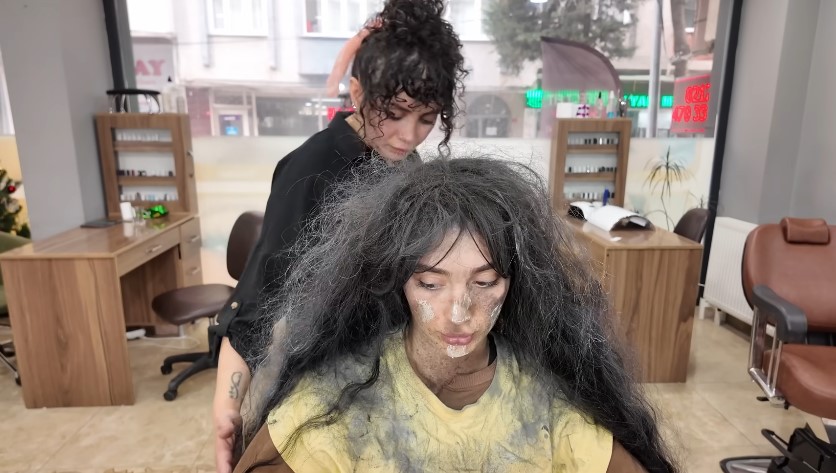She sat near the corner of 9th and Melrose, barely visible to those who rushed by with coffee cups and earbuds. Her coat was torn at the seams, her hair a tangled cloud of gray and dust. Most days, people walked around her like she was a pothole. She had become part of the scenery—ignored, dismissed, invisible.
Her name was Evelyn. She had once been a nurse, a sister, a daughter. Now, she was just “that homeless woman near the bakery.”
But someone noticed her.
Maya Jensen, a documentary filmmaker with a passion for capturing raw human stories, passed by Evelyn one crisp November morning. Unlike the others, Maya didn’t keep walking. She stopped. She crouched down. She spoke.
“Hi. I’m Maya. What’s your name?”
Evelyn hesitated. She hadn’t heard her name spoken kindly in years. Her eyes darted, searching for mockery. Instead, she saw sincerity.
“Evelyn,” she whispered.
That day, Maya sat with Evelyn for nearly two hours. She didn’t bring cameras, or food, or promises—just presence. She listened as Evelyn slowly unfolded pieces of her life: the hospital job, the car crash that left her unable to work, the lost apartment, the friends who vanished, the cold nights.
By the end of the week, Maya returned—with a plan.
A project called “Reframe”—a short film spotlighting unhoused women and their hidden potential. Evelyn would be the first.
At first, Evelyn resisted. “Why would anyone want to see me?” she asked.
Maya only smiled. “Because you’re not invisible.”
Over the next several weeks, Evelyn was given the kind of attention most of us take for granted: clean clothes, warm meals, a haircut, and a place to sleep. But more than that, she was given dignity.
And the transformation? It stunned everyone.
Gone was the stooped figure in threadbare layers. Evelyn now walked with her shoulders back, hair trimmed into soft waves, eyes alert and shining. She looked twenty years younger. Not because of makeup or clothes—but because she was being seen.
The day the film was released online, it exploded. Evelyn’s story was shared around the world. People cried. People donated. A fundraiser soared past its goal within 24 hours. Evelyn’s image was on morning shows, podcasts, even the cover of a popular lifestyle magazine.
But here’s where the story should have ended—where hope triumphs and a new life begins.
Only it didn’t.
Because Evelyn wasn’t who she said she was.
Two months later, a federal agent named Lucas Harrow watched Evelyn’s viral transformation on his niece’s iPad. Something about her face tugged at his memory. He ran a facial recognition scan through a secure government archive.
Match found.
The woman known to the world as “Evelyn from 9th Street” was actually Dr. Evelyn Marsh, a former biochemical researcher who had vanished from a top-secret defense project eight years ago.
Presumed dead.
Harrow didn’t wait. The next day, he flew to Los Angeles.
By the time he arrived, Evelyn was living in a fully furnished apartment, donated by an anonymous benefactor. Maya was preparing a second film—a longer feature chronicling Evelyn’s “new life.”
Harrow showed up during filming.
Evelyn saw him and froze. The camera kept rolling.
“Dr. Marsh,” he said softly. “We need to talk.”
Maya lowered the camera. “What’s going on?”
Evelyn turned to her. “I didn’t lie. I was homeless. Everything I told you… was true. But I didn’t tell you everything.”
“Who are you?” Maya whispered.
Evelyn exhaled. “I used to work for a facility in Maryland. We were developing nanotech for neural mapping. For memory repair. We were close to something… revolutionary. But the military wanted to weaponize it. They didn’t want to heal minds—they wanted to control them.”
“And you walked away?” Maya asked.
“I leaked the truth to a whistleblower group. Then I ran,” Evelyn said. “I thought if I vanished—really vanished—they’d leave me alone. So I did what no one expects: I became no one.”
“And now?” Harrow asked.
“I think I’ve been found,” she said. Her voice was calm. “That viral video? It put me back on the map. And not just for you.”
That night, Evelyn’s apartment was broken into.
No money was taken. No electronics. Just one thing: the worn duffel bag Evelyn had kept since the streets. Inside had been the last backup of her work—encrypted, disguised as a child’s toy.
It was gone.
The next morning, Evelyn disappeared.
No one saw her leave.
Maya was devastated. She released a public plea for Evelyn’s return. Donations surged again. Searches began. But Evelyn was gone.
Weeks later, Maya received a package. No return address.
Inside: a flash drive. A single video file.
It was Evelyn—calm, smiling, standing on a forest trail somewhere unknown.
“Maya,” she said, “thank you. You helped me believe in people again. I’m safe, for now. But they have what they wanted. And I have to make sure they can’t use it. Not like they planned.”
“The world saw me when I was invisible. That was a gift. But now, I need to disappear again—on my terms.”
“Tell my story. But leave this part out.”
Maya didn’t listen.
She made the second film.
She told everything.
And weeks later, she vanished too.
